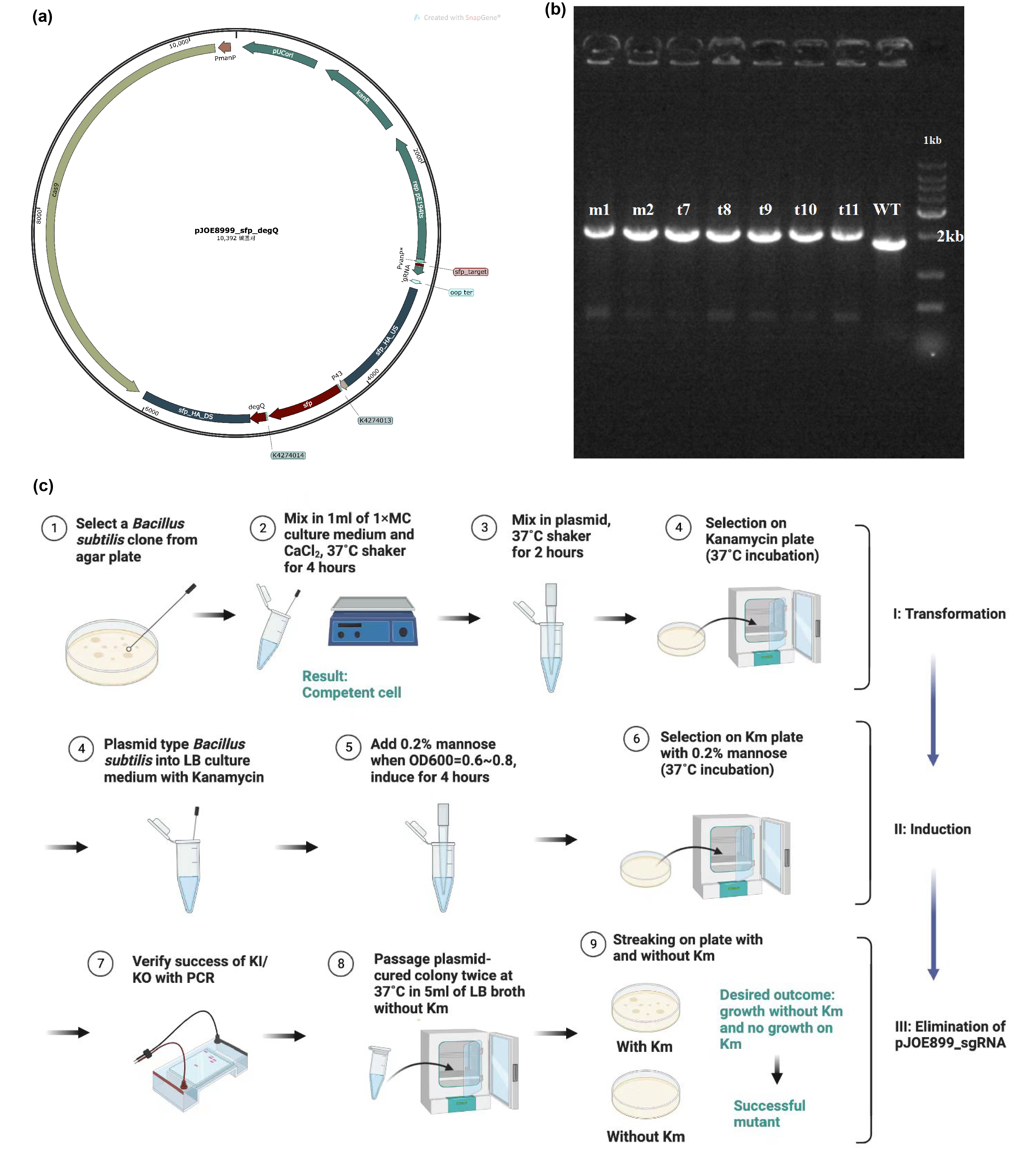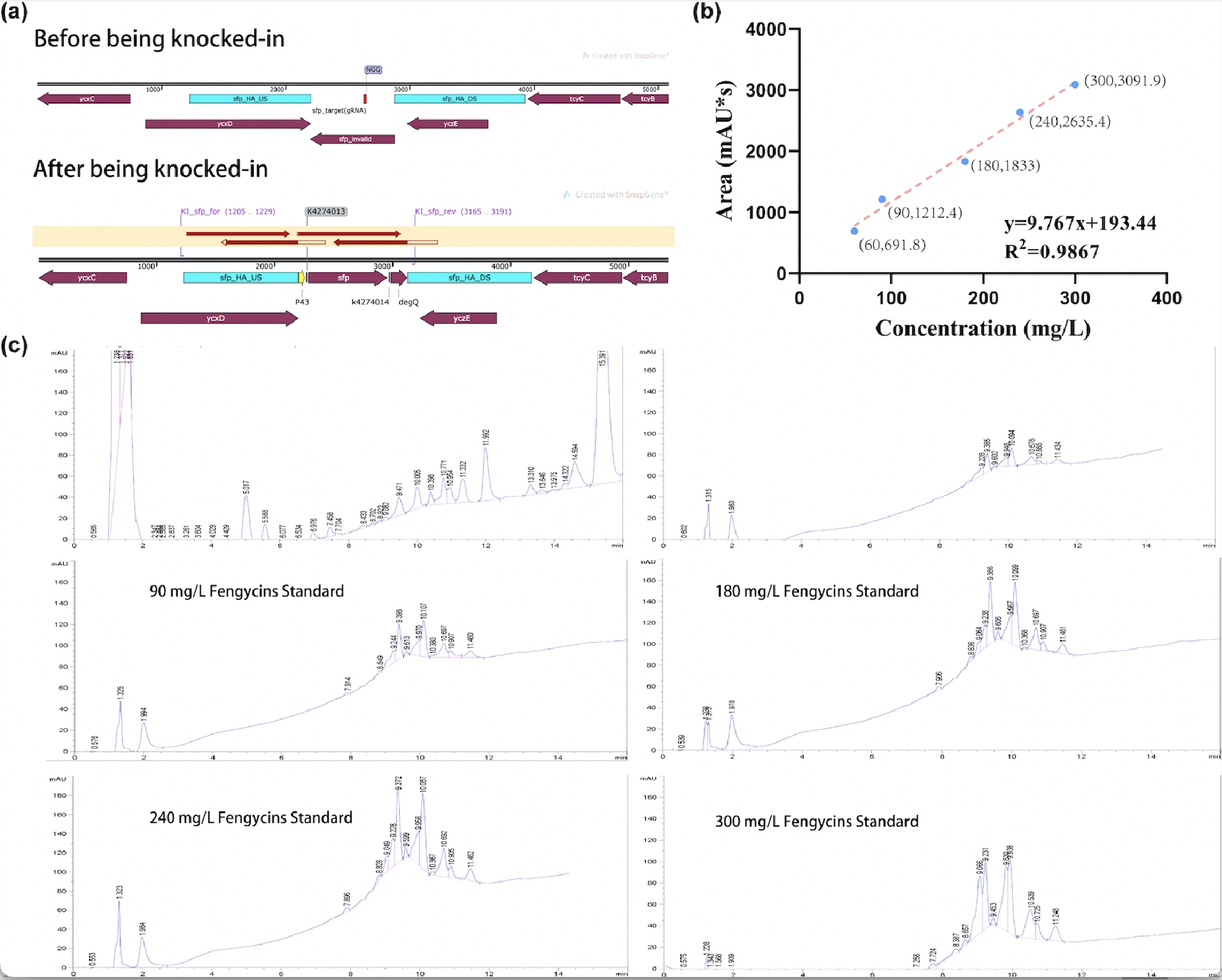Part:BBa_K4274035
PvanP*-sfp_target-sfp_HA_US-p43-K4274013-sfp-K4274014-degQ-sfp_HA_DS
This part starts with the promoter PvanP* (Part: BBa_K4274006), a semi-synthetic promoter that promotes the constitutive expression of the single guide RNAs used in this composite part. Then, we have encoded sfp_target (Part: BBa_K4274008), the guide RNA for sfp (Part: BBa_K4274009) and degQ (Part: BBa_K4274010) knock-in. sfp_HA_US (part: BBa_K4274011) is the following sequence in this composite part. It performs the role of the donor DNA. We then encoded p43 (Part: BBa_K143013), a constitutive promoter for the following sequences. The promoter is followed by synthetic ribosome binding site in pJOE8999 (Part: BBa_K4274013). P43 is followed by degQ (Part: BBa_K4274010), a regulator gene that assists in the production of lipopeptide. The last coding sequence in this composite part is sfp_HA_DS (Part: BBa_K4274012), the donor DNA that provides the knock-in gene sequence. The composite part ends with the terminator B0015 (Part: BBa_B0015).
This part contains the parts that conducts the knock-out of the the mutant sfp gene in Bacillus subtilis, which comprises patB_target (Part: BBa_K4274007), PvanP* (Part: BBa_K4274006), and PvanP*-patB_target (Part: BBa_K4274036). On the other hand, the series of parts participating in sfp and degQ knock-in comprises Sfp_target (BBa_K4274008), sfp (Part: BBa_K4274009), degQ (Part: BBa_K4274010), sfp_HA_US (part: BBa_K4274011), sfp_HA_DS (Part: BBa_K4274012), synthetic RBS1 in pJOE8999 (Part: BBa_K4274013), synthetic RBS2 in pJOE8999 (Part: BBa_K4274014), and this composite part (Part: BBa_K4274035).
Contents
Usage and Biology
We applied the CRISPR_Cas9 mechanism to achieve sfp and degQ knocked-in. The coding sequence sfp_target (Part: BBa_K4274008) is the single guide RNA that assists the Cas9 protein to locate the targeted sequence. Both sfp_HA_US (part: BBa_K4274011) and sfp_HA_DS (Part: BBa_K4274012) are donor DNA sequences that inserts the desired modified gene sequence in between the broken DNA fragments. Our sfp (Part: BBa_K4274009) gene sequence is a part derived from B. amyloliquefaciens FZB42, performing the role of a primer for nonribosomal peptide synthesis. K4274013 (Part: BBa_K4274013) and K4274014 (Part: BBa_ K4274014) are respectively ribosome binding sites cloned into pJOE8999 to express sfp and degQ. After the modification of knocking-in sfp and degQ genes in the region of mutant sfp, it would enable Bacillus subtilis 168 to produce fengycins.
Source
sfp from B. amyloliquefaciens FZB42 and degQ from Bacillus subtilis 168.
Sequence and Features
- 10INCOMPATIBLE WITH RFC[10]Illegal XbaI site found at 1102
Illegal PstI site found at 1209 - 12INCOMPATIBLE WITH RFC[12]Illegal PstI site found at 1209
- 21COMPATIBLE WITH RFC[21]
- 23INCOMPATIBLE WITH RFC[23]Illegal XbaI site found at 1102
Illegal PstI site found at 1209 - 25INCOMPATIBLE WITH RFC[25]Illegal XbaI site found at 1102
Illegal PstI site found at 1209
Illegal NgoMIV site found at 1266 - 1000INCOMPATIBLE WITH RFC[1000]Illegal SapI.rc site found at 1832
Characterization
The main composite of our product, fengycins, is produced by engineering Bacillus subtilis 168. As it is shown in the demonstration in description, sfp and degQ genes are critical to the biosynthesis of fengycins. Besides, Bacillus subtilis 168 possesses a natural but invalid sfp gene, and the functional degQ gene is silenced with the regulation of a weak promoter.Thus, with the help of pJOE8999_sfp_degQ plasmid (Figure 1a), we knocked in both sfp gene and degQ gene in the region of the natural sfp gene of Bacillus subtilis 168 after being knocking out. Under the guidance of protocol, we successfully transformed and induced the plasmid to function as a gene editor (Figure 1c). After induction, 7 strains were selected for PCR and electrophoresis verification. Since successful knock-in would would result in a 252 bps increase in the genome of Bacillus subtilis 168, the electrophoresis result conveys preliminarily that all of these strains has achieved our target of constructing the fengycins producers (Figure 1b).

After sequencing further verified that the successful construction of the fengycins producing strain, we used the strain for fermentation (Figure 2a). For the quantification of fengycins production, the methanol - extract obtained from the fermentation broth was analyzed by high performance liquid chromatography (HPLC). The peak of fengycins appeared at the retention time of 8-11.5 min under methanol mobile phase (Figure 2c). The injection sample was a solution of lipopeptide extract from 30 mL of fermentation broth dissolved in 7 mL methanol. Besides, various concentrations of fengycins standard is also injected for the construction of the standard curve of peak area obtained by HPLC (y) and its corresponding fengycins’ concentration (x). Based on the standard curve, we got the regression curve and its corresponding formula y=9.767x+193.44, and R2>0.98 displays that the regression equation fits the observed values (Figure 2b). Substituting y=1242.3 obtained from the sample into the regression equation, the concentration of fengycin in methanol solution can be calculated as 107.4 mg/L, that is, 25.06 mg/L of fengycins can be achieved by shaking-flask fermentation.

Sequence and features
Sequence and Features
- 10COMPATIBLE WITH RFC[10]
- 12COMPATIBLE WITH RFC[12]
- 21COMPATIBLE WITH RFC[21]
- 23COMPATIBLE WITH RFC[23]
- 25INCOMPATIBLE WITH RFC[25]Illegal NgoMIV site found at 1541
- 1000COMPATIBLE WITH RFC[1000]
| None |
